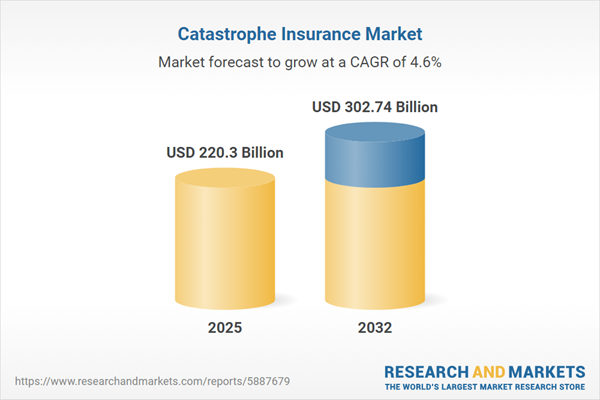Speak directly to the analyst to clarify any post sales queries you may have.
The catastrophe insurance market is adapting to more complex risks, technological innovation, and heightened customer expectations, demanding agile responses from insurers and informed strategies from senior decision-makers.
Catastrophe Insurance Market Snapshot
The catastrophe insurance market grew from USD 210.99 billion in 2024 to USD 220.30 billion in 2025. With a projected CAGR of 4.61%, the sector is expected to reach USD 302.74 billion by 2032. Global dynamics are shaped by rising climate-driven natural disasters and emerging man-made threats, compelling insurers to revise their approaches to risk modeling, underwriting, and claims management. Technological and regulatory trends underscore a rapidly evolving environment that requires strategic foresight and flexible execution.
Scope & Segmentation
This report provides in-depth segmentation, highlighting major coverage types, risk drivers, and channel dynamics essential for market participants. The primary keyword 'catastrophe insurance market' is central to the analysis, ensuring robust on-page SEO. Key coverage areas include:
- Catastrophe Type: Man-made threats (cyber-attacks, industrial accidents, terrorism) and natural disasters (earthquakes, floods, hurricanes, wildfires).
- Coverage Type: Catastrophic health, earthquake, flood, pandemic, storm, terrorism, and volcano insurance policies, tailored for commercial, personal, and residential exposures.
- Claim Type: Partial losses and total losses, affecting reserve management and claims processing strategies.
- Distribution Channel: Agency, bancassurance, brokers, and digital & direct platforms reaching diverse customer segments.
- Regional Scope: Americas (North America, Latin America), Europe, Middle East & Africa, and Asia-Pacific, encompassing key countries and regional growth drivers.
- Company Trends: Strategic initiatives, partnerships, and technology adoption across a range of global carriers, reinsurers, and innovators.
Key Takeaways for Senior Leaders
- Advanced data science and satellite imagery support more precise risk assessment, enabling flexible capital allocation and dynamic pricing strategies.
- Parametric insurance is gaining adoption for rapid post-catastrophe liquidity, allowing insurers and clients to address recovery needs with increased efficiency.
- Regulatory reforms are demanding stricter solvency standards and consistent climate-related disclosures, shaping insurer compliance priorities and stakeholder interactions.
- Customer-centric innovations, including usage-based and on-demand products accessible via digital channels, are redefining policyholder engagement and acquisition strategies.
- Global events are reshaping supply chain risk management, making partnerships with contractors and infrastructure providers a growing priority for continuity planning.
- Regional disparities highlight tailored adoption approaches: for example, sovereign risk pools in Latin America, advanced analytics in East Asia, and resilience bonds in the Middle East.
Tariff Impact on Premium Structures and Recovery
Recent changes in United States tariff policies have driven up raw material costs, directly affecting reconstruction and claim payouts following catastrophic events. Insurers are revisiting loss projections, introducing cost escalation clauses, and diversifying reinsurance arrangements to adapt. These shifts have also triggered a reevaluation of supply chain risk and post-event recovery protocols, intensifying collaboration across the ecosystem for faster claims adjustment and streamlined rebuilding.
Methodology & Data Sources
This report leverages a rigorous combination of primary and secondary research. Senior executives and specialists contributed insights through in-depth interviews and surveys. These findings were validated with an extensive review of industry databases, regulatory filings, and modeling studies. Sophisticated analytical tools, such as geospatial risk mapping and Monte Carlo simulations, ensure robust market forecasting and segmentation accuracy.
Why This Report Matters
- Enables senior decision-makers to benchmark their strategies against emerging risk trends, technology adoption, and regional growth variations.
- Provides actionable intelligence for optimizing risk transfer, capital allocation, and claims readiness within diverse market settings.
- Supports leadership in responding proactively to evolving customer needs, regulatory requirements, and supply chain vulnerabilities.
Conclusion
Senior leaders in catastrophe insurance must balance innovation, resilience, and partnership to succeed in an increasingly complex and technology-driven environment. This report delivers the necessary intelligence for strategic planning and market leadership.
Additional Product Information:
- Purchase of this report includes 1 year online access with quarterly updates.
- This report can be updated on request. Please contact our Customer Experience team using the Ask a Question widget on our website.
Table of Contents
3. Executive Summary
4. Market Overview
7. Cumulative Impact of Artificial Intelligence 2025
Companies Mentioned
The companies profiled in this Catastrophe Insurance market report include:- Admiral Group PLC
- Allianz SE
- American International Group, Inc.
- Aon PLC
- Arch Capital Group Ltd.
- Assurant, Inc.
- Aviva PLC
- AXA Group
- Brown & Brown, Inc.
- California Earthquake Authority
- Chubb Group of Companies
- Everest Group, Ltd.
- FM Global
- Hippo Enterprises Inc.
- International Catastrophe Insurance Managers, LLC
- Kin Insurance, Inc.
- Liberty Mutual Holding Company Inc.
- Lloyd’s of London
- Marsh & McLennan Companies, Inc.
- Münchener Rückversicherungs-Gesellschaft Aktiengesellschaft
- Pacesetter Claims Service Inc.
- PartnerRe Ltd. by Covéa Coopérations
- Pilot Catastrophe
- Prudential Financial, Inc.
- RENFROE
- SCOR SE
- Selective Insurance Group, Inc.
- SOMPO Holdings, Inc.
- Swiss Re Ltd.
- Talanx AG
- The Allstate Corporation
- The Cigna Group by Health Care Service Corporation
- The Progressive Corporation
- Tokio Marine Holdings
- Tower Limited
- Zurich Insurance Group Ltd.
Table Information
| Report Attribute | Details |
|---|---|
| No. of Pages | 196 |
| Published | November 2025 |
| Forecast Period | 2025 - 2032 |
| Estimated Market Value ( USD | $ 220.3 Billion |
| Forecasted Market Value ( USD | $ 302.74 Billion |
| Compound Annual Growth Rate | 4.6% |
| Regions Covered | Global |
| No. of Companies Mentioned | 37 |









